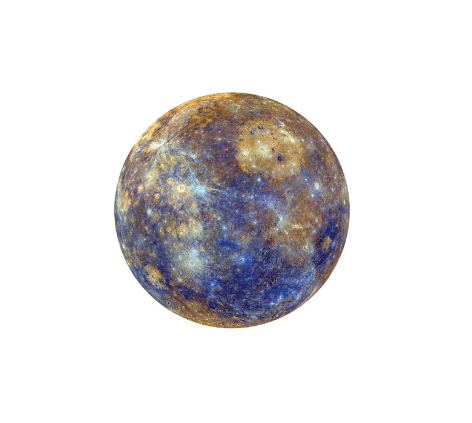Mercury is the smallest rocky (terrestrial) planet in the solar system. It is the closest to the Sun and has almost no atmosphere. Mercury is a geologically inactive celestial body. It is named after the Roman god Mercury (Hermes in Greek mythology), the messenger of the gods.

| Caractéristiques | Mercure | Terre |
| Diamètre | 4 880 km | 12 750 km |
| Rapport de masse | 0,055 | 1 |
| Rapport de gravité | 0,38 | 1 |
| Distance de soleil (UA) | 0,38 | 1 |
| Inclinaison / Axe de rotation | 0,01° | 23,5° |
| Période de rotation | 176 j | 1 j |
| Révolution autour du soleil | 88 j | 365 j |
| Température max | +430°C | +58°C |
| Température min | -180°C | -89°C |
| Lunes | 0 | 1 |
Mercury is the closest planet to the Sun and the smallest in the solar system.
General Characteristics
- Mercury orbits very close to the Sun, at an average distance of 58 million kilometers.
- It is relatively small, with a diameter of about 4,880 km.
- Mercury rotates slowly on its axis, making a day last approximately 59 Earth days. However, its orbit around the Sun is much faster, meaning that its year is shorter than its day, lasting about 88 Earth days.
Surface
- Mercury’s surface is heavily cratered, similar to the Moon, due to meteorite impacts over millions of years.
- Large solidified lava plains, called lava maria, were formed by ancient volcanic eruptions.
- The planet has unique geological formations called scarps, which are giant cliffs formed by the cooling and contraction of Mercury’s crust.
Atmosphere and Temperature
- Mercury has a very thin and sparse atmosphere, mainly composed of water vapor, oxygen, sodium, hydrogen, helium, and potassium. Due to its weak gravity and proximity to the Sun, atmospheric molecules are constantly lost to space.
- Because of its lack of atmosphere and close proximity to the Sun, Mercury experiences extreme temperature variations, from +430°C during the day to -180°C at night.
Exploration
Several space missions have been sent to explore Mercury, providing detailed data on its composition and surface. For more information, visit:
